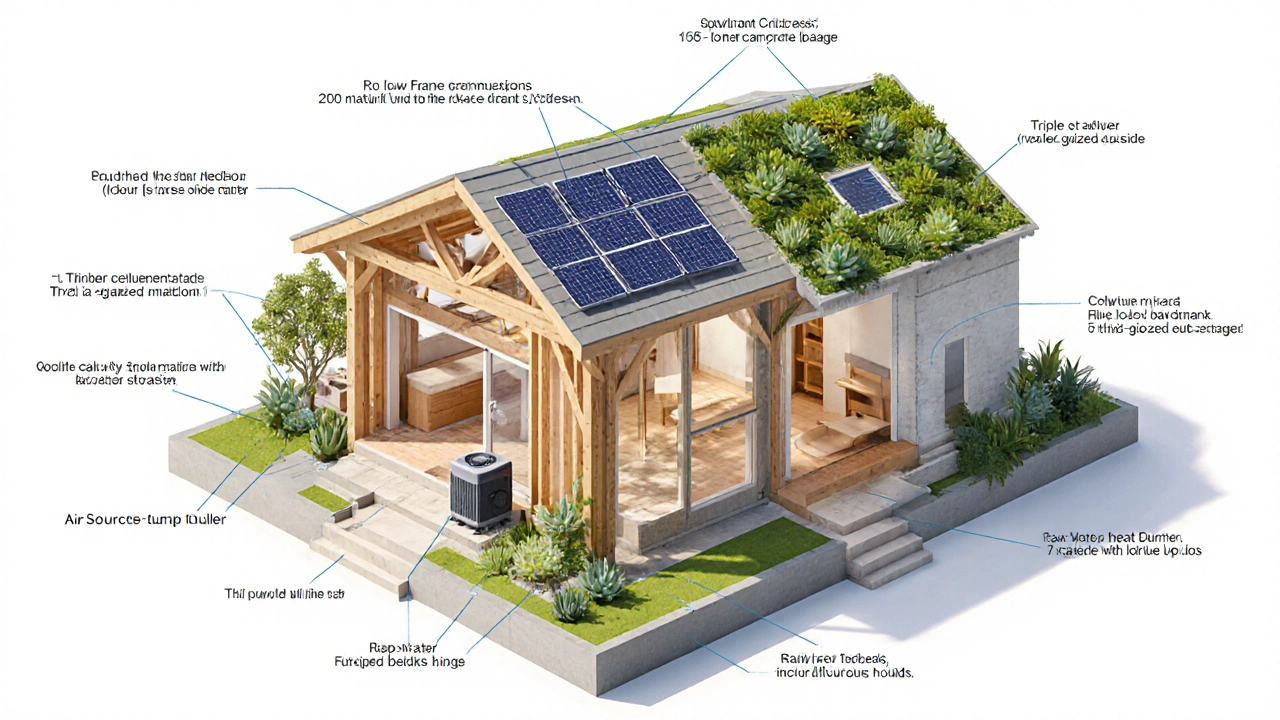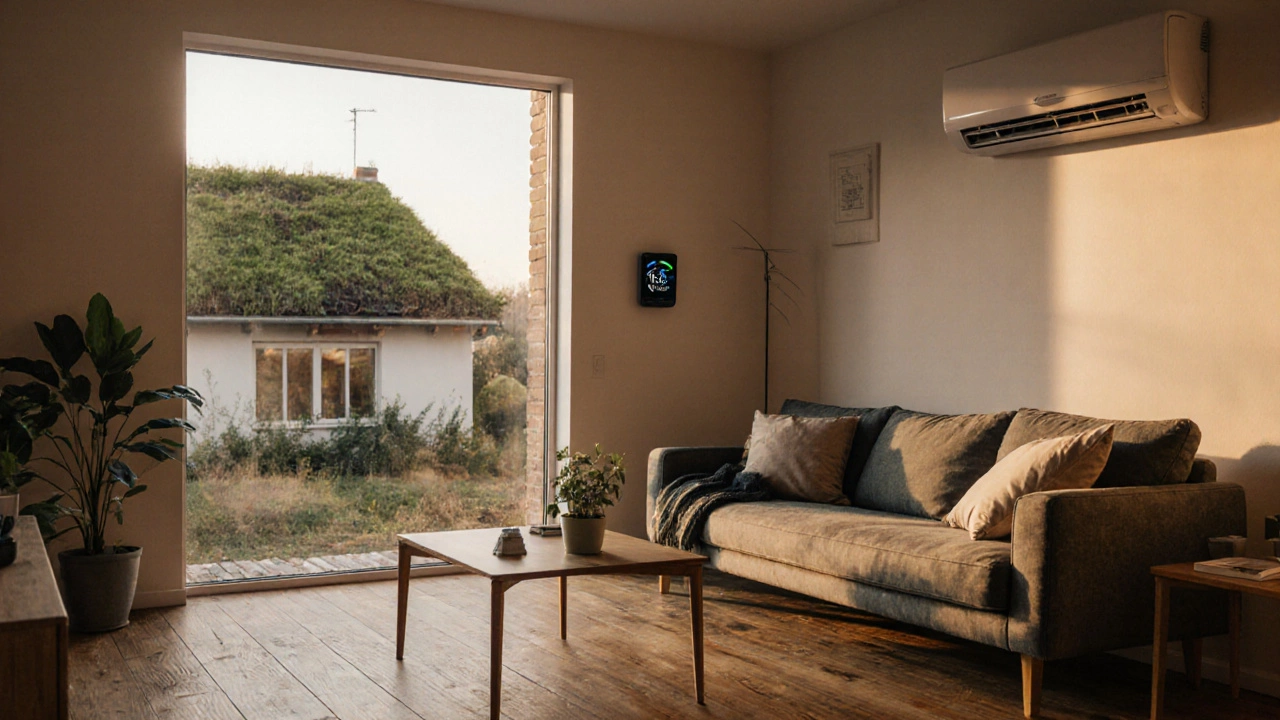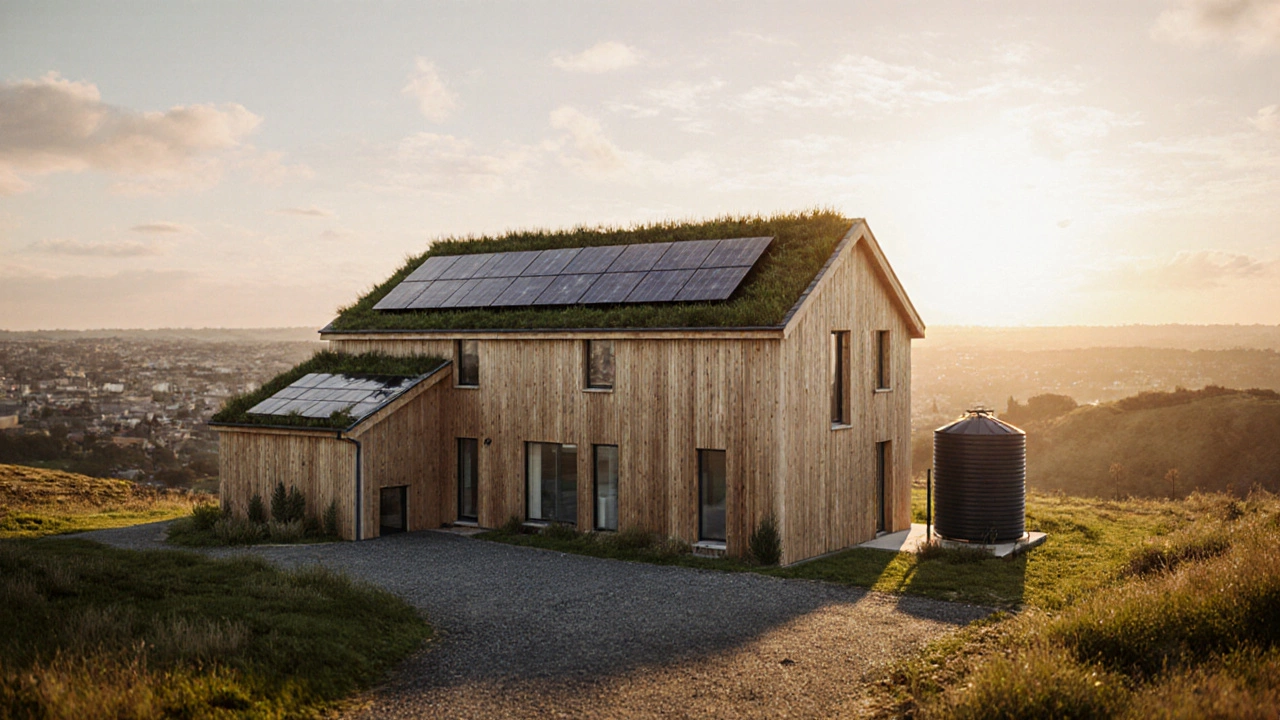Sustainable House Cost Calculator
Customize Your Build
Your Estimated Cost Breakdown
Enter your details above to see your estimate
Key Takeaways
- A fully sustainable house in 2025 typically costs €250,000-€500,000 in Ireland, depending on size and site.
- The biggest cost drivers are the building envelope (insulation, windows) and renewable energy systems.
- Government grants, SEAI rebates, and green mortgages can shave 10‑20% off the total bill.
- Choosing low‑carbon materials like timber frames or rammed earth can lower both upfront spend and long‑term carbon footprint.
- Detailed budgeting, a phased build, and careful contractor selection are essential to stay on track.
Building a home that leaves almost no environmental trace is no longer a dream. Homeowners in Dublin and beyond are asking the hard question: how much does it cost to build a fully sustainable house? The answer isn’t a single number - it’s a range shaped by land, size, local regulations, and the level of green tech you pack in. Below you’ll find a step‑by‑step cost breakdown, real‑world price examples, and practical tips to keep the budget under control while hitting every sustainability target.
What Exactly Is a Fully Sustainable House?
Sustainable house is a dwelling designed to minimize energy use, use renewable resources, and reduce embodied carbon throughout its life cycle. In practice that means targeting a net‑zero energy balance, airtight construction, and on‑site water management. Two common standards help define the level of performance:
- Net-zero energy home produces as much renewable energy on site as it consumes over a year.
- Passive house focuses on super‑high insulation, airtightness, and heat‑recovery ventilation to keep heating demand below 15 kWh/m² per year.
When you combine the two you get a truly “fully sustainable” build - low energy demand covered by on‑site solar, heat pumps, and water‑saving systems.
Major Cost Drivers in 2025
Understanding where the money goes is the first step to controlling it. Below is a typical cost breakdown for a 150m² (1,600ft²) family home in the Greater Dublin area.
| Component | Typical Cost (€) | Notes |
|---|---|---|
| Land acquisition | €60,000-€100,000 | Depends on location; brownfield sites often cheaper. |
| Foundation & structure | €45,000-€70,000 | Include low‑carbon concrete or timber frame. |
| Building envelope (insulation, airtightness) | €55,000-€85,000 | High‑performance energy‑efficient windows triple‑glazed, low‑U‑value units and spray‑foam or cellulose insulation. |
| Renewable energy systems | €30,000-€55,000 | ~5kW solar photovoltaic (PV) system covers most electricity demand plus battery storage. |
| Heating & cooling | €20,000-€35,000 | Air‑source heat pump provides space heating, cooling, and hot water. |
| Water management | €8,000-€12,000 | Rainwater harvesting system stores roof runoff for non‑potable uses. |
| Green roof / landscaping | €12,000-€20,000 | Provides insulation, stormwater retention, and biodiversity. |
| Finishes & fixtures | €25,000-€40,000 | Low‑VOC paints, recycled‑content flooring. |
| Professional fees & permits | €15,000-€25,000 | Architect, engineer, planning consent, SEAI certification. |
| Contingency (10%) | €30,000-€45,000 | For unexpected site conditions or price swings. |

Average Cost Range in 2025
When you add up the line items above, a fully sustainable 150m² home in Dublin typically lands between €250,000 and €500,000. Smaller houses (under 100m²) can be built for as low as €180,000, while larger, luxury builds can exceed €750,000. Urban infill sites push the land cost up, whereas rural plots can shave €30,000-€50,000 off the total.
Compare that with a conventional build of the same size, which averages €180,000-€260,000. The premium for sustainability is roughly 30‑60% upfront but drops dramatically when you factor in lower utility bills and higher resale value (often a 5‑10% boost).
Financing, Grants & Incentives
Ireland’s Sustainable Energy Authority (SEAI) offers a suite of rebates that can offset the biggest expenses:
- Solar PV grant: up to €1,500 per kW installed for residential systems.
- Heat‑pump grant: €2,500 for air‑source units (up to €4,000 for ground‑source).
- Home Energy Retrofit Scheme (HERS): up to €20,000 for deep‑retrofit works, applicable to new builds that meet certain energy‑performance criteria.
Many banks now provide “green mortgages” with a 0.2‑0.3% lower interest rate when you can document at least 30% of the build cost is dedicated to renewable technologies. A rough rule of thumb: combine SEAI rebates with a green mortgage and you can shave about €30,000-€50,000 off the final bill.
Step‑by‑Step Budget Planning Checklist
- Define your sustainability targets (net‑zero, Passive House, or a hybrid).
- Secure land and run a site‑analysis for solar orientation and wind exposure.
- Hire an architect experienced with low‑carbon design. Ask for a preliminary cost estimate broken down by envelope, systems, and finishes.
- Obtain a detailed quote from a builder that specializes in timber frame or insulated concrete forms.
- Apply for SEAI grants early - they require a pre‑approval before installation.
- Set aside a 10% contingency fund for unexpected soil conditions or material price spikes.
- Finalize financing - consider a green mortgage or personal loan with a sustainability clause.
- Schedule regular cost reviews against the budget - adjust finishes or system sizes if you’re overshooting.

Pro Tips to Reduce the Sustainable Build Price
- Standardize the module size. Using a uniform wall panel (e.g., 2.4m × 6m) reduces waste and labor hours.
- Phase renewable systems. Install a smaller PV array first, then expand as budget allows.
- Source reclaimed timber. It often meets the structural grade while cutting material costs by 15‑20%.
- Self‑build some interior work. DIY painting, flooring, and even basic carpentry can save €5,000-€10,000.
- Opt for a simple roof shape. A low‑slope roof is cheaper to install and still supports a green roof.
Real‑World Example: The “Celtic Green” Cottage
In 2024 a couple in County Wicklow commissioned a 140m² sustainable cottage. Here’s how the numbers unfolded:
- Land: €75,000 (small rural plot).
- Structure: Timber frame with insulated concrete form infill - €60,000.
- Envelope: Triple‑glazed windows, cellulose insulation - €65,000.
- Solar PV (4kW): €12,000 after a €4,000 SEAI grant.
- Air‑source heat pump: €18,000, reduced by a €2,500 grant.
- Rainwater harvest & green roof: €15,000.
- Finishes (recycled hardwood floors, low‑VOC paint): €30,000.
- Professional fees & permits: €20,000.
- Contingency (10%): €26,500.
Total cost: €301,500. After grants and a green mortgage, the net out‑of‑pocket expense dropped to roughly €260,000. Annual energy bills are now under €400, giving a payback period of about 12 years - well within the typical 15-20‑year horizon for net‑zero homes.
Quick Comparison: Sustainable vs. Conventional House
| Metric | Sustainable House | Conventional House |
|---|---|---|
| Construction Cost | €250,000-€500,000 | €180,000-€260,000 |
| Annual Energy Use | ≈ 5kWh/m² (net‑zero) | ≈ 150kWh/m² |
| Annual Energy Bill | €300-€500 | €1,800-€2,400 |
| Resale Premium | +5%-10% | Baseline |
| Carbon Embodied | ≈ 120kg CO₂/m² | ≈ 250kg CO₂/m² |
Even though the up‑front spend is higher, the long‑term savings, comfort, and environmental impact make the sustainable option a compelling investment for most Irish families.
Frequently Asked Questions
What is the minimum size for a net‑zero house?
There’s no hard minimum - the key is keeping the heating demand low. A compact 80m² layout can reach net‑zero with a 3‑kW PV array and a modest heat pump, especially if it’s well‑insulated and airtight.
Do I need planning permission for a green roof?
Yes, most local authorities treat a green roof as a structural alteration. You’ll usually submit a structural report and a drainage plan alongside your standard house‑building application.
How long does it take to get SEAI grants?
The SEAI aims for a 4‑week turnaround after you submit the installation evidence. It helps to file the application as soon as the contractor completes the work, not after the final hand‑over.
Can I combine a heat pump with a gas boiler?
Hybrid systems are common in Ireland’s cooler climate. The heat pump handles the base load, while a small gas boiler kicks in during extreme cold spells, keeping comfort high without oversizing the electric system.
What’s the typical payback period for a solar‑PV system?
A 5kW residential PV system in Dublin usually recoups its cost in 8‑12years, depending on electricity tariffs and whether you add battery storage.
Bottom line: building a fully sustainable house in 2025 is a sizable financial commitment, but with careful planning, smart material choices, and the right incentives, the numbers become manageable. Start by mapping your sustainability goals, run the cost breakdown, and tap into the SEAI programs - that’s the fastest route to turning your green‑home dream into a realistic budget.
